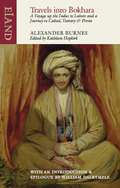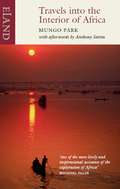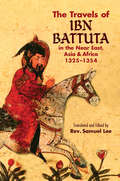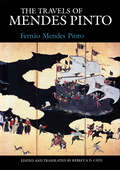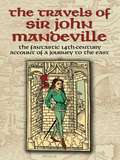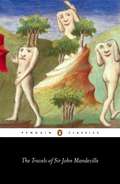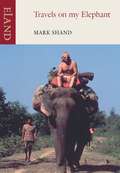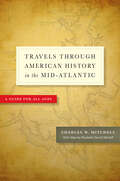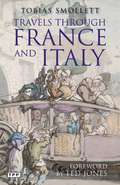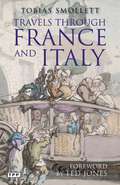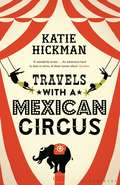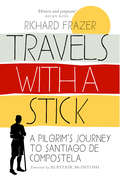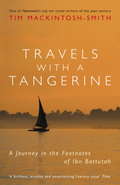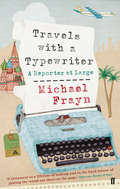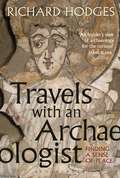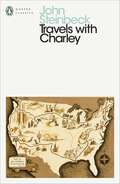- Table View
- List View
Travels into Bokhara: A Voyage up the Indus to Lahore and a Journey to Cabool, Tartary & Persia
by Alexander BurnesAt the age of only twenty six, Alexander Burnes proved himself to be one of the most effective intelligence agents of his time. Making two dangerous journeys beyond the frontiers of the Indian Empire, he reported back via the East India Company to Downing Street on the geography and politics of the kingdoms that lay to the northwest as far as fabled Bokhara. He travelled simply, disguised as a local, but with his rapier-like mind, an ear for languages and an infectious charm and curiosity, he had a formidable arsenal of talents at his command. In 1835, the publication of Burnes's Travels into Bokhara made him a celebrity in London, where he lectured to packed halls and was even given an audience by the King. This brand new edition brings the heady sense of excitement, risk and zeal bursting from the pages.
Travels into the Interior of Africa
by Mungo ParkMungo Park's account of his journeys into West Africa in 1795 and again in 1805 provided Europeans with their first reliable description of the interior of the continent. Though he failed in the object of his mission -to chart the course of the Niger River -he succeeded in leaving a unique record of everyday life before the exploitation of Africa by Europeans, as valuable today as it was then. His first-hand experiences of tribal justice, gold mining and the slave trade are recorded, as well as his own understated heroism, a story of courage, open-hearted friendship and betrayal.
The Travels of Ibn Battuta: in the Near East, Asia and Africa, 1325-1354
by Ibn BattutaThe Arab equivalent of Marco Polo, Sheikh Ibn Battuta (1304-77) set out as a young man on a pilgrimage to Mecca that ended 27 years and 75,000 miles later.The only medieval traveler known to have visited the lands of every Muslim ruler of his time, Ibn Battuta was born into a family of highly respected religious judges and educated as a theologian. Leaving his native city of Tangier in 1326, he traveled — over the next several years — to East Africa, Byzantium, Iraq, southern Russia, India, Ceylon, and China. His account of the journey, dictated on his return, not only provides vivid accounts of an odyssey that took him to exotic lands, but also describes in great detail Muslim maritime activities in the Middle and Far East, fascinating elements of foreign architecture, and agricultural activities of diverse cultures.A rare and important work covering the geography and history of the medieval Arab world, this primary sourcebook will be welcomed by students and scholars for its inherent historical value.
The Travels of Mendes Pinto
by Fernão Mendes PintoThis text, ostensibly the autobiography of Portugese explorer Fernão Mendes Pinto, came second only to Marco Polo's work in exciting Europe's imagination of the Orient. Chronicling adventures from Ethiopia to Japan, Travels covers twenty years of Mendes Pinto's odyssey as a soldier, a merchant, a diplomat, a slave, a pirate, and a missionary, and continues to overwhelm questions about its source with the sheer enjoyment of its narrative. "[T]here is plenty here for the modern reader. . . . The vivid descriptions of swashbuckling military campaigns and exotic locations make this a great adventure story. . . . Mendes Pinto may have been a sensitive eyewitness, or a great liar, or a brilliant satirist, but he was certainly more than a simple storyteller."—Stuart Schwartz, The New York Times
The Travels of Mendes Pinto
by Fernão Mendes PintoThis text, ostensibly the autobiography of Portugese explorer Fernão Mendes Pinto, came second only to Marco Polo's work in exciting Europe's imagination of the Orient. Chronicling adventures from Ethiopia to Japan, Travels covers twenty years of Mendes Pinto's odyssey as a soldier, a merchant, a diplomat, a slave, a pirate, and a missionary, and continues to overwhelm questions about its source with the sheer enjoyment of its narrative. "[T]here is plenty here for the modern reader. . . . The vivid descriptions of swashbuckling military campaigns and exotic locations make this a great adventure story. . . . Mendes Pinto may have been a sensitive eyewitness, or a great liar, or a brilliant satirist, but he was certainly more than a simple storyteller."—Stuart Schwartz, The New York Times
The Travels of Mendes Pinto
by Fernão Mendes PintoThis text, ostensibly the autobiography of Portugese explorer Fernão Mendes Pinto, came second only to Marco Polo's work in exciting Europe's imagination of the Orient. Chronicling adventures from Ethiopia to Japan, Travels covers twenty years of Mendes Pinto's odyssey as a soldier, a merchant, a diplomat, a slave, a pirate, and a missionary, and continues to overwhelm questions about its source with the sheer enjoyment of its narrative. "[T]here is plenty here for the modern reader. . . . The vivid descriptions of swashbuckling military campaigns and exotic locations make this a great adventure story. . . . Mendes Pinto may have been a sensitive eyewitness, or a great liar, or a brilliant satirist, but he was certainly more than a simple storyteller."—Stuart Schwartz, The New York Times
The Travels of Mendes Pinto
by Fernão Mendes PintoThis text, ostensibly the autobiography of Portugese explorer Fernão Mendes Pinto, came second only to Marco Polo's work in exciting Europe's imagination of the Orient. Chronicling adventures from Ethiopia to Japan, Travels covers twenty years of Mendes Pinto's odyssey as a soldier, a merchant, a diplomat, a slave, a pirate, and a missionary, and continues to overwhelm questions about its source with the sheer enjoyment of its narrative. "[T]here is plenty here for the modern reader. . . . The vivid descriptions of swashbuckling military campaigns and exotic locations make this a great adventure story. . . . Mendes Pinto may have been a sensitive eyewitness, or a great liar, or a brilliant satirist, but he was certainly more than a simple storyteller."—Stuart Schwartz, The New York Times
The Travels of Mendes Pinto
by Fernão Mendes PintoThis text, ostensibly the autobiography of Portugese explorer Fernão Mendes Pinto, came second only to Marco Polo's work in exciting Europe's imagination of the Orient. Chronicling adventures from Ethiopia to Japan, Travels covers twenty years of Mendes Pinto's odyssey as a soldier, a merchant, a diplomat, a slave, a pirate, and a missionary, and continues to overwhelm questions about its source with the sheer enjoyment of its narrative. "[T]here is plenty here for the modern reader. . . . The vivid descriptions of swashbuckling military campaigns and exotic locations make this a great adventure story. . . . Mendes Pinto may have been a sensitive eyewitness, or a great liar, or a brilliant satirist, but he was certainly more than a simple storyteller."—Stuart Schwartz, The New York Times
The Travels of Mendes Pinto
by Fernão Mendes PintoThis text, ostensibly the autobiography of Portugese explorer Fernão Mendes Pinto, came second only to Marco Polo's work in exciting Europe's imagination of the Orient. Chronicling adventures from Ethiopia to Japan, Travels covers twenty years of Mendes Pinto's odyssey as a soldier, a merchant, a diplomat, a slave, a pirate, and a missionary, and continues to overwhelm questions about its source with the sheer enjoyment of its narrative. "[T]here is plenty here for the modern reader. . . . The vivid descriptions of swashbuckling military campaigns and exotic locations make this a great adventure story. . . . Mendes Pinto may have been a sensitive eyewitness, or a great liar, or a brilliant satirist, but he was certainly more than a simple storyteller."—Stuart Schwartz, The New York Times
The Travels of Sir John Mandeville: The Fantastic 14th-Century Account of a Journey to the East
by John MandevilleOne of the most influential books of the medieval period, John Mandeville's fourteenth-century work was written, ostensibly, to encourage and instruct pilgrims traveling to the Holy Land. A thorough compendium of medieval lore, the travel book proved to be a great success throughout Europe. (Among his alleged readers were Leonardo da Vinci and Christopher Columbus.) The Travels professes to relate Mandeville's experiences in the Holy Land, Egypt, India, and China--where he served in the Great Khan's army--followed by his journey to "the lands beyond," countries populated by "dog-headed men, cannibals, Amazons, and pygmies." Five centuries after Mandeville recorded his observations in those distant lands, the volume's remarkably exacting accounts of events and geography were found to be probable fabrications.Nevertheless, the book's widespread popularity and influence make it essential to the study of medieval English literature. An engaging mix of fact and fantasy, enhanced with more than 100 rare woodcut illustrations, it has retained its place as one of the greatest and most entertaining works of early English vernacular prose.
The Travels of Sir John Mandeville
by John Mandeville C. MoseleyOstensibly written by an English knight, the Travels purport to relate his experiences in the Holy Land, Egypt, India and China. Mandeville claims to have served in the Great Khan's army, and to have travelled in 'the lands beyond' - countries populated by dog-headed men, cannibals, Amazons and Pygmies. Although Marco Polo's slightly earlier narrative ultimately proved more factually accurate, Mandeville's was widely known, used by Columbus, Leonardo da Vinci and Martin Frobisher, and inspiring writers as diverse as Swift, Defoe and Coleridge. This intriguing blend of fact, exaggeration and absurdity offers both fascinating insight into and subtle criticism of fourteenth-century conceptions of the world.
Travels on my Elephant
by Mark ShandWith the help of a Maratha nobleman, Mark Shand bought an elephant named Tara and rode her over six hundred miles across India to the Sonepur Mela, the world's oldest elephant market. From Bhim, a drink-racked mahout, Shand learned to ride and care for her. From his friend Aditya Patankar he learned Indian ways. And with Tara, his new companion, he fell in love. Travels on My Elephant is the story of their epic journey across India, from packed highways to dusty back roads where communities have remained unchanged for millennia. It is also a memorable, touching account of Tara's transformation from scrawny beggar elephant to star attraction. In this new edition Mark Shand explains how what began as an adventurous whim has developed, decades later, into a life of campaigning to provide vital migratory corridors for these magnificent creatures, whose habitat is under constant assault from man.
Travels through American History in the Mid-Atlantic: A Guide for All Ages
by Charles W. MitchellWinner of the Society for American Travel Writers’ Lowell Thomas Travel Journalism 2016 Gold Award in the Guidebook CategoryFew regions of the United States boast as many historically significant sites as the mid-Atlantic. Travels through American History in the Mid-Atlantic brings to life sixteen easily accessible historical destinations in Pennsylvania, Maryland, Washington, D.C., the Potomac Valley, and Virginia. Charles W. Mitchell walked these sites, interviewed historians and rangers, and read the letters and diaries of the men and women who witnessed—and at times made—history. He reveals in vivid prose the ways in which war, terrain, weather, and illness have shaped the American narrative. Each attraction, reenactment, and interactive exhibit in the book is described through the lens of the American experience, beginning in the colonial and revolutionary eras, continuing through the War of 1812, and ending with the Civil War. Mitchell contrasts the ornate decor of Philadelphia’s Independence Hall, for example, with the passionate debates that led to the Declaration of Independence, and the tranquil beauty of today’s Harpers Ferry with the trauma its citizens endured during the Civil War, when the town six times fell to opposing forces. Excerpts from eyewitness accounts further humanize key moments in the national story. Hand-drawn maps evoke the historical era by depicting the natural features that so often affected the course of events. This engaging blend of history and travel will appeal to visiting tourists, area residents seeking weekend diversions, history buffs, and armchair travelers.
Travels through American History in the Mid-Atlantic: A Guide for All Ages
by Charles W. MitchellWinner of the Society for American Travel Writers’ Lowell Thomas Travel Journalism 2016 Gold Award in the Guidebook CategoryFew regions of the United States boast as many historically significant sites as the mid-Atlantic. Travels through American History in the Mid-Atlantic brings to life sixteen easily accessible historical destinations in Pennsylvania, Maryland, Washington, D.C., the Potomac Valley, and Virginia. Charles W. Mitchell walked these sites, interviewed historians and rangers, and read the letters and diaries of the men and women who witnessedâ€�and at times madeâ€�history. He reveals in vivid prose the ways in which war, terrain, weather, and illness have shaped the American narrative. Each attraction, reenactment, and interactive exhibit in the book is described through the lens of the American experience, beginning in the colonial and revolutionary eras, continuing through the War of 1812, and ending with the Civil War. Mitchell contrasts the ornate decor of Philadelphia’s Independence Hall, for example, with the passionate debates that led to the Declaration of Independence, and the tranquil beauty of today’s Harpers Ferry with the trauma its citizens endured during the Civil War, when the town six times fell to opposing forces. Excerpts from eyewitness accounts further humanize key moments in the national story. Hand-drawn maps evoke the historical era by depicting the natural features that so often affected the course of events. This engaging blend of history and travel will appeal to visiting tourists, area residents seeking weekend diversions, history buffs, and armchair travelers.
Travels through France and Italy: Containing Observations On Character, Customs, Religion, ... With A Particular Description Of The Town, Territory, And Climate Of Nice (Travellers' Classics Ser.)
by Tobias SmollettIn 1763 Tobias Smollett set sail from Folkestone to Boulogne. He would not return to England for two years, during which time he travelled extensively - and in a notoriously ill-tempered fashion - through much of France and Italy. Smollett, seemed 'determined to be pleased with nothing' and was 'sardonic, satirical and decidedly gloomy'. In Paris, everything had 'shrunk' and was twice as expensive as his last visit. Versailles was a 'dismal habitation'. In Rome, he felt that Michelangelo's Last Judgement resembled a mob; his inn in San Remo was more miserable than the worst ale-house in England and in Lerici he was sure he would be poisoned. And yet, there were places where even Smollett could not fail to be captivated. The Maison Carrée in Nimes was 'ravishingly beautiful', Nice was enchanting and the port of Genoa 'dazzling'. His obvious pleasure in the landscapes through which he passed, his keen eye for colourful, telling details and the fact that his letters appear virtually as they were written beautifully illuminate both Smollett's character and the places he visited. Funny, honest and full of subtle magic, Travels through France and Italy is a rare and revealing portrait of 18th century Europe at a time when Marie Antoinette had just become queen of all France, the Grand Tour was in its infancy and Cannes was a quiet fishing village.
Travels through France and Italy
by Tobias SmollettIn 1763, Tobias Smollett set sail from Folkestone to Boulogne. He would not return to England for two years, during which time he travelled extensively - and in a notoriously ill-tempered fashion - through much of France and Italy. Smollett, seemed 'determined to be pleased with nothing' and was 'sardonic, satirical and decidedly gloomy'. In Paris, everything had 'shrunk' and was twice as expensive as his last visit. Versailles was a 'dismal habitation'. In Rome, he felt that Michelangelo's "Last Judgement" resembled a mob; his inn in San Remo was more miserable than the worst alehouse in England and in Lerici he was sure he would be poisoned. And yet, there were places where even Smollett could not fail to be captivated. The Maison Carree in Nimes was 'ravishingly beautiful', Nice was enchanting and the port of Genoa 'dazzling'. His obvious pleasure in the landscapes through which he passed, his keen eye for colourful, telling details and the fact that his letters appear virtually as they were written beautifully illuminate both Smollett's character and the places he visited.Funny, honest and full of subtle magic, "Travels through France and Italy" is a rare and revealing portrait of 18th century Europe at a time when Marie Antoinette had just become queen of all France, the Grand Tour was in its infancy and Cannes was a quiet fishing village.
Travels with a Mexican Circus
by Katie HickmanKatie Hickman went to Mexico looking for magic. She found it in the circus – Big Top, clowns, elephants and all – where cheap, torn materials and tarnished sequins are transformed into nights of glittering illusion. Gradually adjusting to the harsh ways of the circus's nomadic lifestyle, she soon became absorbed into this hypnotic new world, at first as a foreigner but later as 'La Gringa Estrella', a performer in her own right. Travels with a Mexican Circus is an unforgettable account of a year-long journey through an extraordinary and bizarrely beautiful country.
Travels With a Stick: A Pilgrim’s Journey to Santiago de Compostela
by Richard FrazerAlmost 300,000 people ‘officially’ complete the journey to Santiago each year – hundreds of thousands more travel at least part of the way. In this book, Richard Frazer discovers on his pilgrimage to the shrine of St James the Great how a journey – wherever it is made – undertaken with an open and hospitable heart can provide spiritual renewal and transformation, filling what many people see as the spiritual void in 21st century life. This absorbing account reveals how the pilgrim journey can be nourishment for the human heart. It connects us to landscape and brings us to the mystery of what it is to be human and vulnerable and open to the kindness of strangers and the gift of the new and the unexpected.
Travels with a Tangerine: A Journey in the Footnotes of Ibn Battutah
by Tim Mackintosh-SmithIbn Battutah set out in 1325 from his native Tangier on the pilgrimage to Mecca. By the time he returned twenty-nine years later, he had visited most of the known world, travelling three times the distance Marco Polo covered. Spiritual backpacker, social climber, temporary hermit and failed ambassador, he braved brigands, blisters and his own prejudices. The outcome was a monumental travel classic. Captivated by this indefatigable man, award-winning travel writer Tim Mackintosh-Smith set out on his own eventful journey, retracing the Moroccan's eccentric trip from Tangier to Constantinople. Tim proves himself a perfect companion to this distant traveller, and the result is an amazing blend of personalities, history and contemporary observation.
Travels with a Typewriter: A Reporter at Large
by Michael FraynIn mid-career, Michael Frayn took up his old trade of journalism, and wrote a series of occasional articles for the Observer about some of the places in the world that interested him. He wanted to describe 'not the extraordinary but the ordinary, the typical, the everyday', and his accounts became the starting point for some of the novels and plays he wrote later. From a kibbutz in Israel to summer rains in Japan, bicycles in Cambridge to Notting Hill at the end of the 1950s, they are glimpses of a world that sometimes seems tantalisingly familiar, sometimes vanished forever. Michael Frayn is the celebrated author of fifteen plays including Noises Off, Copenhagen and Afterlife. His bestselling novels include Headlong, which was shortlisted for the Man Booker Prize, Spies, which won the Whitbread Best Novel Award and Skios, which was longlisted for the Man Booker Prize. "All writers of fiction should be required by law to go out and do a bit of reporting from time to time, just to remind them how different the real world in front of their eyes is from the invented world behind them." Michael Frayn 'Whether he's on a kibbutz or a bicycle, Frayn makes acute observations and the writing is enchanting.' Conde Nast Traveller
Travels with an Archaeologist: Finding a Sense of Place
by Richard Hodges'You must be very patient', most everyone asserts admiringly on encountering an archaeologist. Patience in the pursuit of history instantly earns consideration. Patience to sift through the soil to discover treasure, from gold to unidentifiable knick-knacks – an educated beachcomber. But, patience does not come into it so much as the chemistry of experiences from being in the company of others as the five senses are provoked and satisfied by the buried unexpected. Archaeology is about hearing, seeing, smelling, tasting and touching past textures in our time. With these senses, in the company of friends, new places are created from old ones. Travel with archaeologist and writer Richard Hodges as he explores sites across the globe and ponders the relationship of the individual with the past and the present of the past in its ruins, monuments and traces of distant worlds and civilisations.
Travels with an Archaeologist: Finding a Sense of Place
by Richard Hodges'You must be very patient', most everyone asserts admiringly on encountering an archaeologist. Patience in the pursuit of history instantly earns consideration. Patience to sift through the soil to discover treasure, from gold to unidentifiable knick-knacks – an educated beachcomber. But, patience does not come into it so much as the chemistry of experiences from being in the company of others as the five senses are provoked and satisfied by the buried unexpected. Archaeology is about hearing, seeing, smelling, tasting and touching past textures in our time. With these senses, in the company of friends, new places are created from old ones. Travel with archaeologist and writer Richard Hodges as he explores sites across the globe and ponders the relationship of the individual with the past and the present of the past in its ruins, monuments and traces of distant worlds and civilisations.
Travels with Charley: In Search of America (Penguin Modern Classics)
by John Steinbeck Jay PariniIn 1960, when he was almost sixty years old, John Steinbeck set out to rediscover his native land. He felt that he might have lost touch with its sights, sounds and the essence of its people. Accompanied only by his dog, Charley, he travelled all across the United States in a pick-up truck. His journey took him through almost forty states, and he saw things that made him proud, angry, sympathetic and elated. All that he saw and experienced is described with remarkable honesty and insight. Nobel Prize-winning author John Steinbeck is remembered as one of the greatest and best-loved American writers of the twentieth century. During the 1930s, his works included The Red Pony, Pastures of Heaven, Tortilla Flat, In Dubious Battle, and Of Mice and Men. The Grapes of Wrath, published in 1939, earned him a Pulitzer Prize. In 1962, he was awarded the Nobel Prize for Literature.
